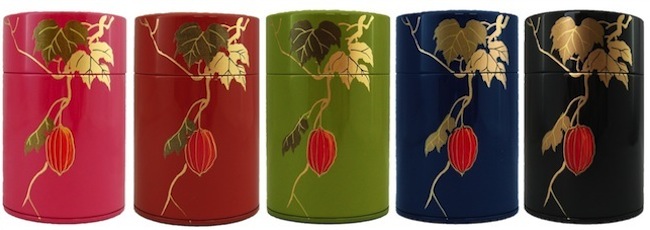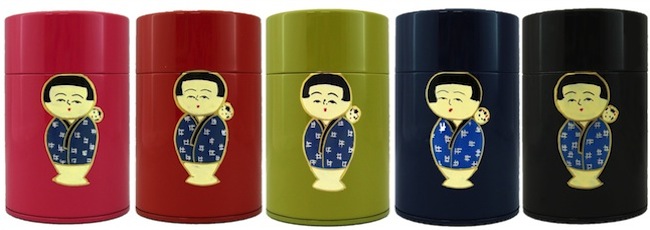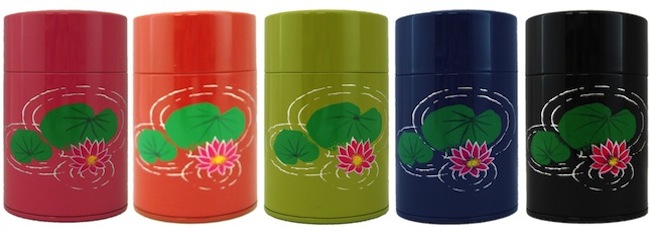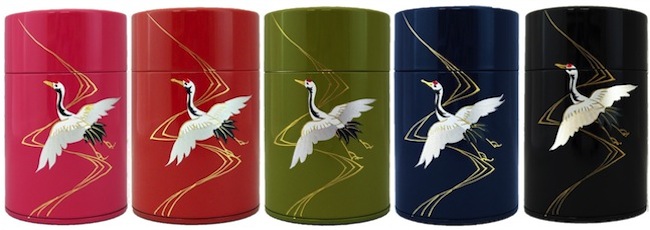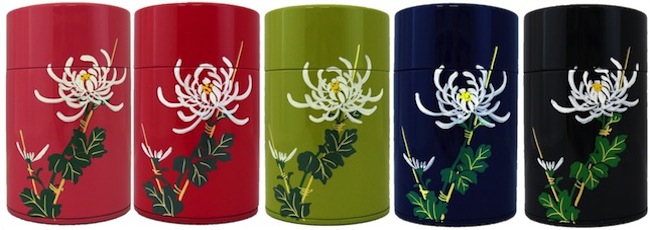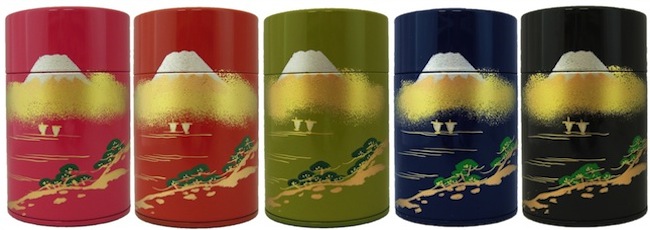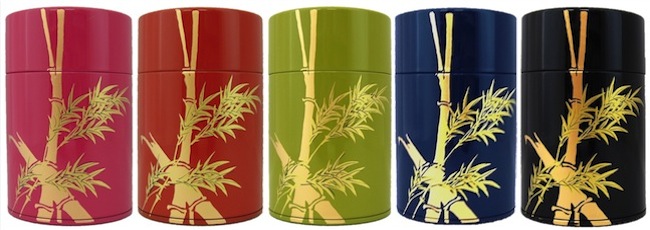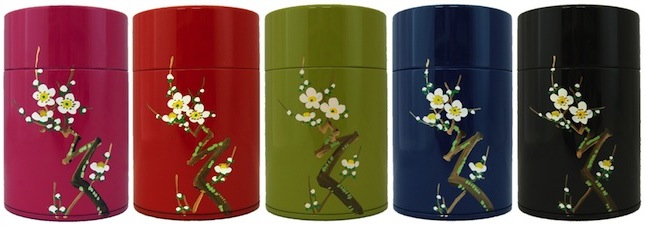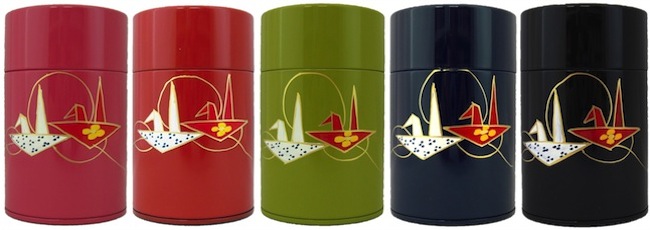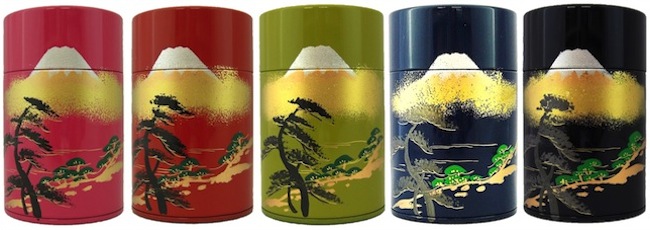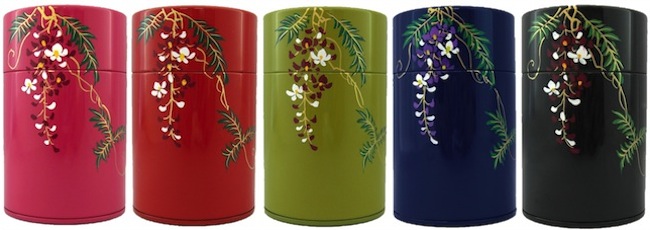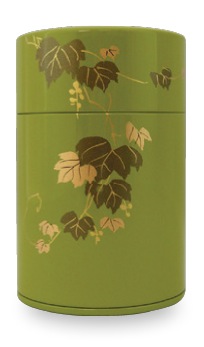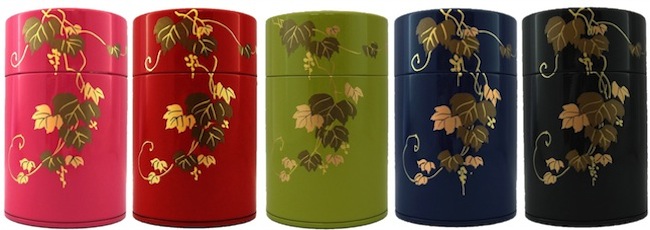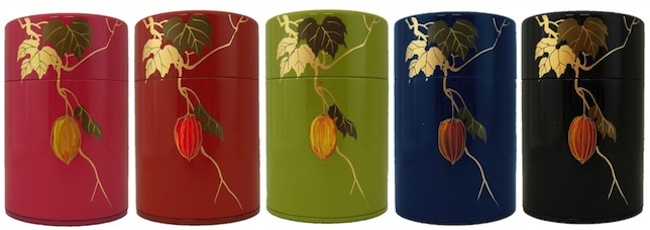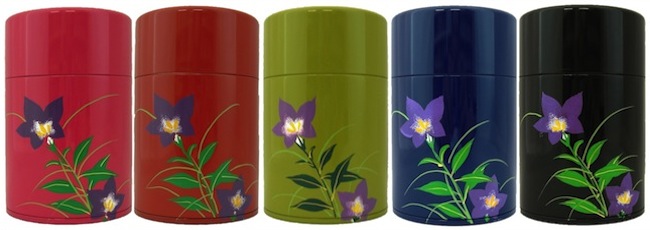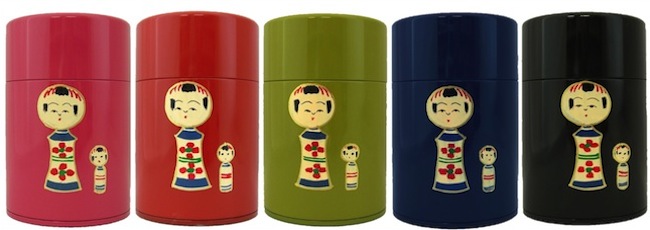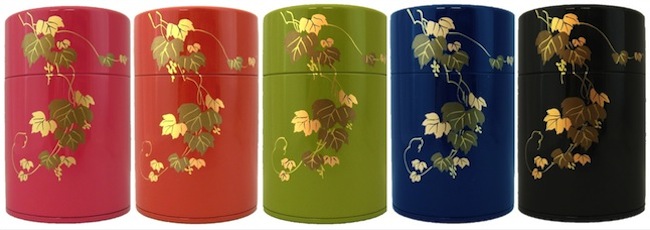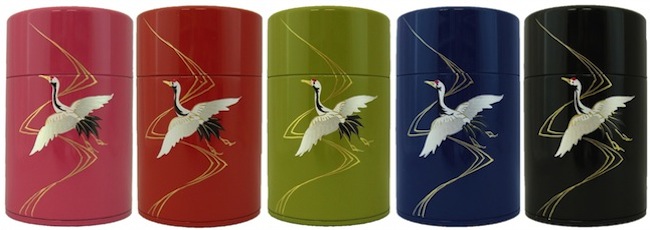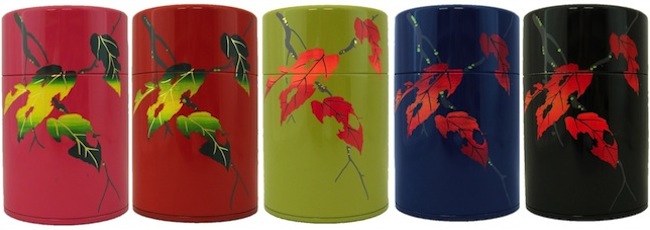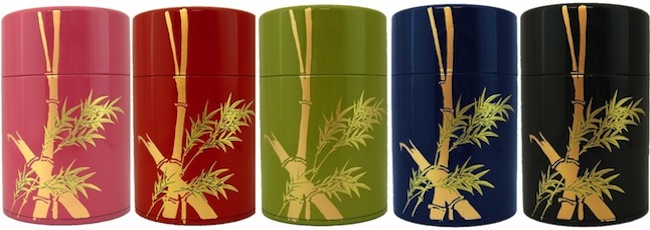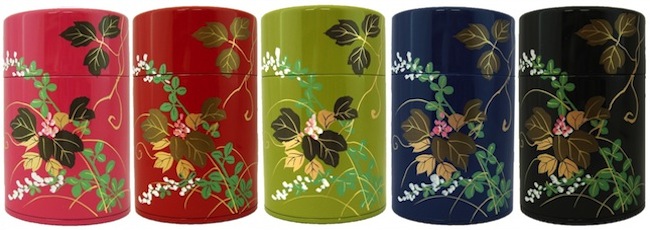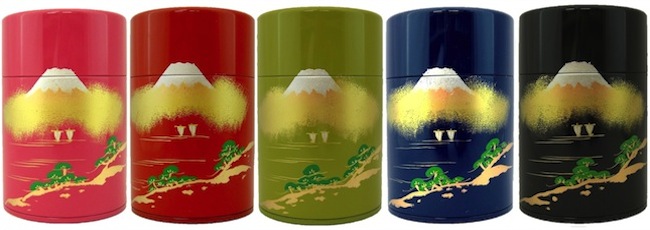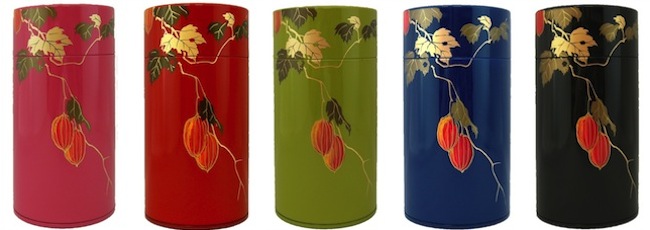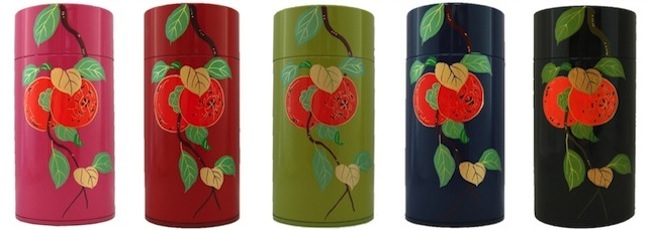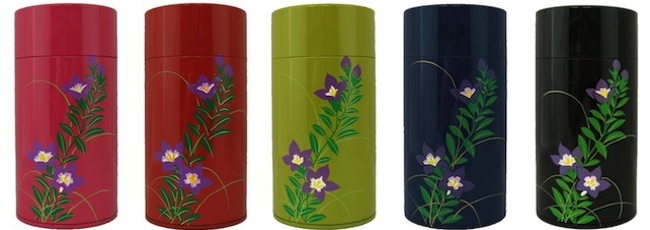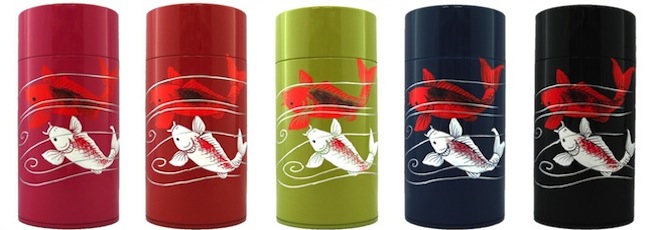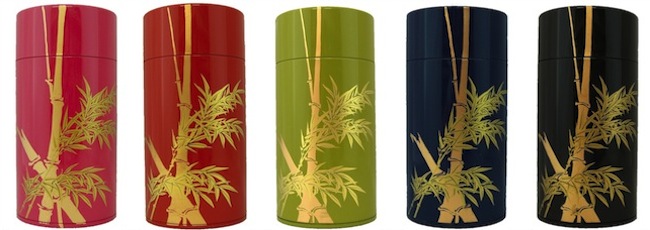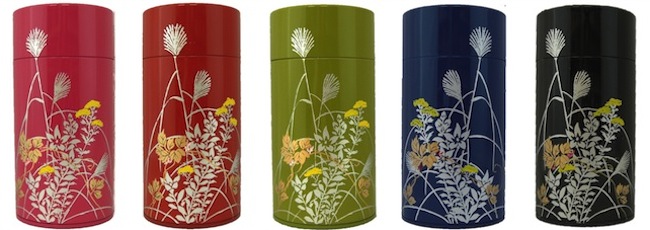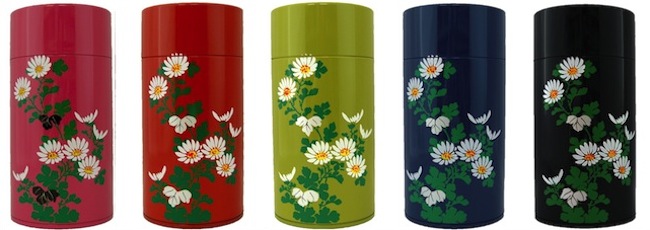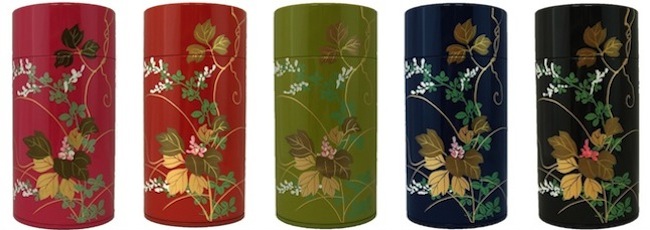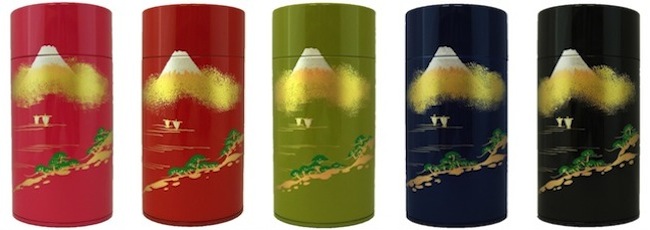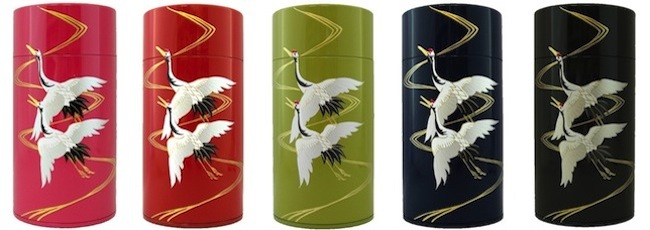MAKIE TIN TEA CANISTERS
Traditional Japanese beauty. Hand painted by skilled artists, each tin tea canister is a true masterpiece.
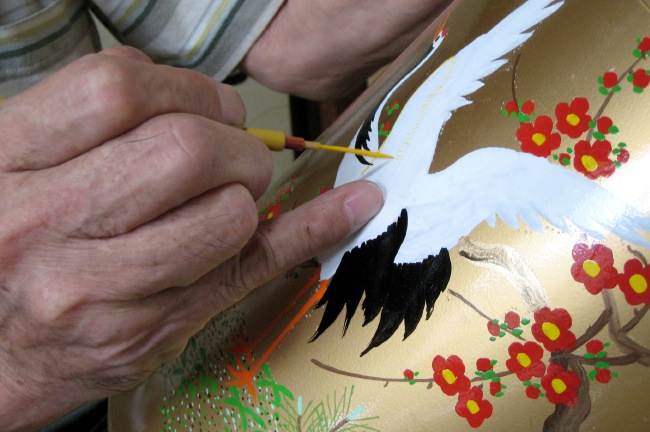

Design Variations
Our Makie Tea Canisters are available in a wide array of designs. Each picture depicts a traditionally Japanese image.

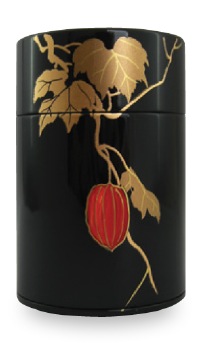
Karasuuri (Wild Gourd)
The karasuuri, or Japanese Snake Gourd, bears its ripe fruit in early Autumn, signaling the end of summer. Its flowers are unique, only blossoming at night and closing in the morning.
Its name in Japanese, karasuuri, translates to "Crow Gourd," and it is said that the plant gets its name because the fruit is a favorite treat of crows.

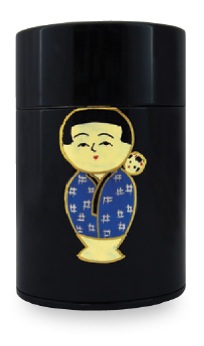
Komori Kokeshi (Dolls)
The kokeshi is a traditional wooden doll that originates from Northern Japan. It was first made by craftsmen that were proficient in their skills of the pottery mill, and spread as a souvenir in hot-spring areas.
Today the kokeshi continues to be a popular gift souvenir for people who visit the Tohoku (northern) region of Japan.

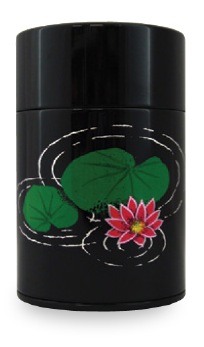
Suiren (Water Lily)
The water lily has been an important part of Japanese aestheticism as seen by the western world. Among the most famous is Claude Monet's water lily garden, which he cherished and which became the theme of many of his paintings.
In Japan the water lily can be found in traditional gardens, adding a vivid dash of color to the atmosphere.


Ichiwa-Zuru (Crane)
The crane is the national bird of Japan and has been an important part of Japanese culture and folklore for centuries. The crane symbolizes longevity and good fortune and is often woven into a wedding kimono as a lucky symbol.
One famous folktale of the crane is called "The Grateful Crane," a story about a crane giving back to an old couple that saves it from a hunting trap. The crane transforms into a beautiful young lady to weave a cloth made from its own feathers.

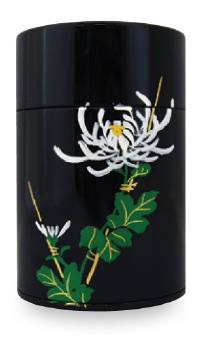
Ogiku (Kiku Flower)
The chrysanthemum has been cherished in Japan for a long time and has much cultural significance.
The flower, in Japanese, is called Kiku-no-hana or Kiku. Originally as medicine, the kiku is said to have come to
Japan as early as the 8th century. During the medieval times, the royalty came to covet the flower as they believed that it held the power to prolong life.
The kiku has been a symbol of the imperial family for centuries, and was officially adopted as the symbol of the royal family in 1869.

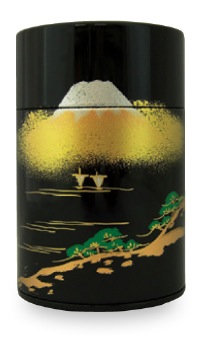
Fuji-to-Aomatsu (Mt. Fuji and Pine)
Mt. Fuji has long been revered as a sacred mountain, and continues to be the object of worship in Shintoism to this day.
Mt. Fuji, or Fuji-san, has been depicted in countless art pieces and is the quintessential symbol of Japan.
Having recently become a world heritage, the symmetry of Mt. Fuji continues to attract people worldwide today.

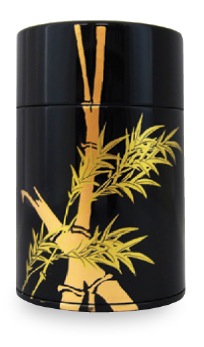
Kintake (Gold Bamboo)
Bamboo is considered a symbol of strength and prosperity in Japan, because they sprout up straight towards the sky and reach full length in a matter of weeks. The bamboo plant will last for centuries and is green throughout the year.
The bamboo flower only blossoms once in its entire lifespan of over a hundred years, over the course of a few days. Very few have seen the bamboo flower, and it is considered very good fortune to come across one.

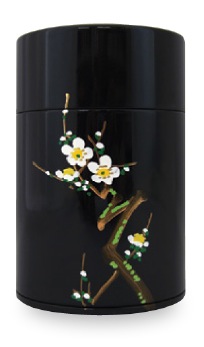
Hakubai (Plum Blossom)
The ume, or Japanese plum, has played an important role in Japanese culture for many centuries. Blooming in the late winter, the flower is thought to signal the start of spring.
Along with the cherry blossom, the plum tree is one of the most symbolic seasonal flowers of Japan.

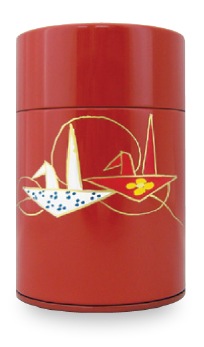
Ori-Zuru (Paper Cranes)
In Japanese culture, origami paper cranes symbolize hope. It is a common tradition for Japanese people to fold one thousand paper cranes as a lucky charm or talisman. The tradition, called Senbazuru (literally one thousand cranes), is said to bestow good fortune upon whomever receives the gift.

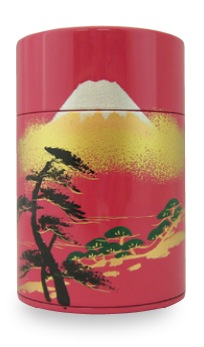
Fuji-to-Kuromatsu (Mt. Fuji and black pine)
Mt. Fuji has long been revered as a sacred mountain, and continues to be the object of worship in Shintoism to this day.
Mt. Fuji, or Fuji-san, has been depicted in countless art pieces and is the quintessential symbol of Japan. Having recently become a world heritage, the symmetry of Mt. Fuji continues to attract people worldwide today.
The kuromatsu, or black pine, is a popular object of bonsai arrangements. Its dark surface is considered majestic and dignified.

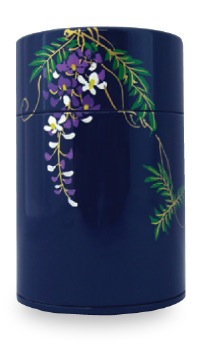
Fuji (Wisteria)
Flowering in early summer, wisteria flowers have been a popular theme of Japanese kimono design for hundreds of years. The wisteria was often celebrated at parties sponsored by Japanese aristocrats in the late Heian period, where they would read poems about its beauty. Later on, Fuji-musume, a style called the Wisteria Maiden, became a popular subject of fine art and doll-making. The wisteria can also be seen used in various family crests.



Karasuuri (Wild Gourd)
The karasuuri, or Japanese Snake Gourd, bears its ripe fruit in early Autumn, signaling the end of summer. Its flowers are unique, only blossoming at night and closing in the morning.
Its name in Japanese, karasuuri, translates to "Crow Gourd," and it is said that the plant gets its name because the fruit is a favorite treat of crows.

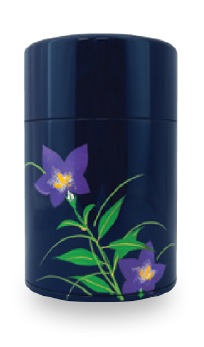
Kikyo (Balloon Flower)
The kikyo flower was a popular motif amongst Japanese warriors, and can be found on many family crests. Considered one of the seven plants of autumn, the blossoming of the kikyo flower signals the end of summer and the arrival of fall.

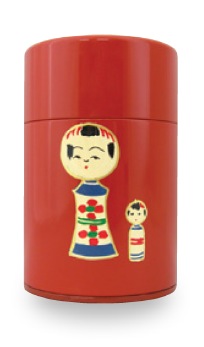
Kokeshi (Dolls)
The kokeshi is a traditional wooden doll that originates from Northern Japan. It was first made by craftsmen that were proficient in their skills of the pottery mill, and spread as a souvenir in hot-spring areas.
Today the kokeshi continues to be a popular gift souvenir for people who visit the Tohoku (northern) region of Japan.

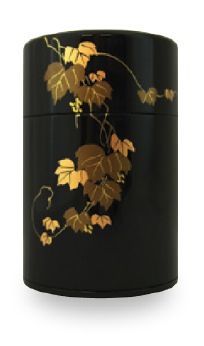
Budou (Grapevines)
The grapevine is popular as a symbol for family crests in Japan an can be seen in various Japanese traditional patterns.
In Japan, the grape is a symbol for prosperity because it bears many ripe fruits.

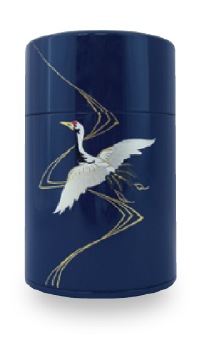
Ichiwa-Zuru (Crane)
The crane is the national bird of Japan and has been an important part of Japanese culture and folklore for centuries. The crane symbolizes longevity and good fortune and is often woven into a wedding kimono as lucky symbol.
One famous folktale of the crane is called "The Grateful Crane," a story about a crane giving back to an old couple that saves it from a hunting trap. The crane transforms into a beautiful young lady to weave a cloth made from its own feathers.


Kareha (Autumn Leaves)
Perhaps it is a unique virtue of the Japanese that they can find beauty in evanescence. The fleeting beauty of turning leaves attract hundreds of thousands of tourists to Kyoto and other places known for their beautiful landscapes every autumn.

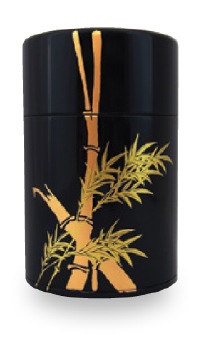
Kintake (Gold Bamboo)
Bamboo is considered a symbol of strength and prosperity in Japan, because they sprout up straight towards the sky and reach full length in a matter of weeks. The bamboo plant will last for centuries and is green throughout the year.
The bamboo flower only blossoms once in its entire lifespan of over a hundred years, over the course of a few days. Very few have seen the bamboo flower, and it is considered very good fortune to come across one.


Hakubai (Plum Blossom)
The ume, or Japanese plum, has played an important role in Japanese culture for many centuries. Blooming in the late winter, the flower is thought to signal the start of spring.
Along with the cherry blossom, the plum tree is one of the most symbolic seasonal flowers of Japan.

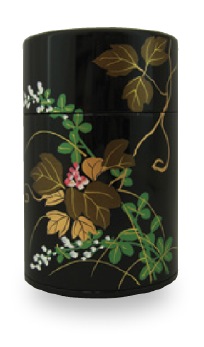
Hagi (Bush Clovers)
The Bush clover blossoms in late summer, and is considered as one of the seven autumn plants that signal the end of summer.
Traditionally the hagi, along with rice dumplings, is presented as an offering to the moon in rituals.

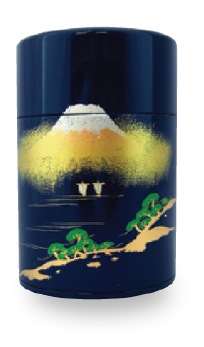
Fuji-to Aomatsu (Mt. Fuji and Pine)
Mt. Fuji has long been revered as a sacred mountain, and continues to be the object of worship in Shintoism to this day.
Mt. Fuji, or Fuji-san, has been depicted in countless art pieces and is the quintessential symbol of Japan.
Having recently become a world heritage, the symmetry of Mt. Fuji continues to attract people worldwide today.


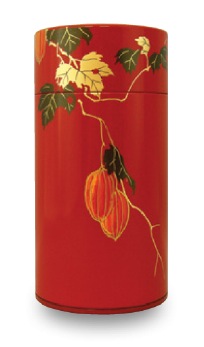
Karasuuri (Wild Gourd)
The karasuuri, or Japanese Snake Gourd, bears its ripe fruit in early Autumn, signaling the end of summer. Its flowers are unique, only blossoming at night and closing in the morning.
Its name in Japanese, karasuuri, translates to "Crow Gourd," and it is said that the plant gets its name because the fruit is a favorite treat of crows.

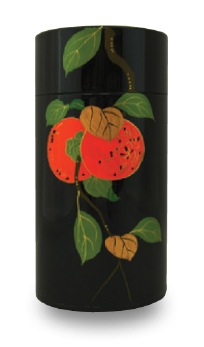
Kaki (Persimmon)
Persimmons are a popular fruit that can be found sold in stores or growing on trees in gardens throughout Japan. Said to have originated in the norther region of China, it has been recorded that kaki was enjoyed as a fruit in Japan as early as the 13th century.
Also a popular theme in poetry, it is one of the most widely recognized symbols of autumn in Japan.

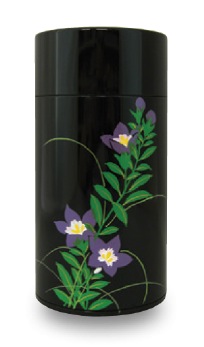
Kikyo (Balloon Flower)
The kikyo flower was a popular motif amongst Japanese warriors, and can be found on many family crests.
Considered one of the seven plants of autumn, the blossoming of the kikyo flower signals the end of summer and the arrival of fall.

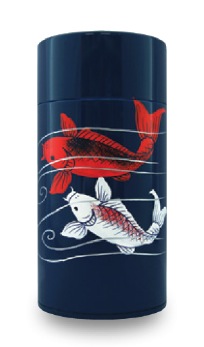
Koi (Carp)
Koi has been enjoyed by the Japanese as a popular ornamental fish. While koi can be found in ponds and rivers all over Japan, the Nishikigoi, koi bred specifically for ornamental purposes, can at times be sold for over ten thousand dollars each.
Because the Koi is often seen swimming against river currents, it is considered a symbol of success in life.

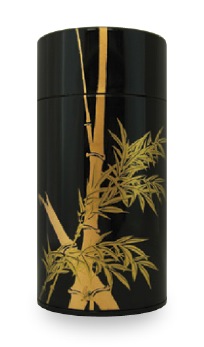
Kintake (Gold Bamboo)
Bamboo is considered a symbol of strength and prosperity in Japan, because they sprout up straight towards the sky and reach full length in a matter of weeks. The bamboo plant will last for centuries and is green throughout the year.
The bamboo flower only blossoms once in its entire lifespan of over a hundred years, over the course of a few days. Very few have seen the bamboo flower, and it is considered very good fortune to come across one.

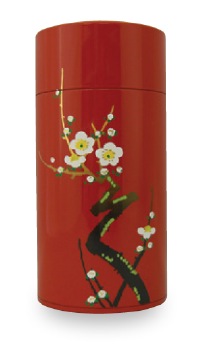
Hakubai (Plum Blossom)
The ume, or Japanese plum, has played an important role in Japanese culture for many centuries. Blooming in the late winter, the flower is thought to signal the start of spring.
Along with the cherry blossom, the plum tree is one of the most symbolic seasonal flowers of Japan.

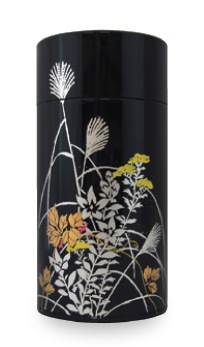
Susuki (Susuki Grass)
Susuki grass is commonly found in most areas of rural Japan during autumn. While the susuki grass may seem dull and uninteresting, the Japanese have found beauty in its simplicity for centuries, even appearing in the Manyoshu, the country's oldest poetry collection.

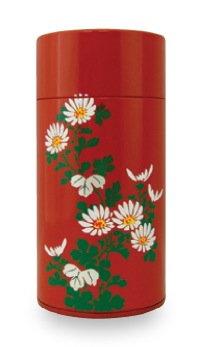
Kogiku (Daisy)
Daisies are as popular in Japan as they have been worldwide.
Its subtle beauty has attracted the fascination of countless artist throughout the ages.

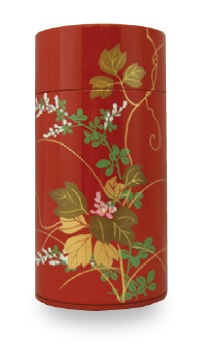
Hagi (Bush Clovers)
The Bush clover blossoms in late Summer, and is considered as one of the seven Autumn plants that signal the end of Summer.
Traditionally the hagi, along with rice dumplings, is presented as an offering to the moon.

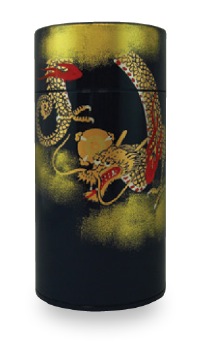
Doragon (Dragon)
The Japanese dragon is thought to be a water deity, often associated with abundant water and rain. An important character in folklore and buddhism in Japan, the dragon is painted on the ceilings of temples around the country.
In Shinto, the dragon is also depicted as a water god and is worshipped in many shrines as a god that brings rain and good fishing.

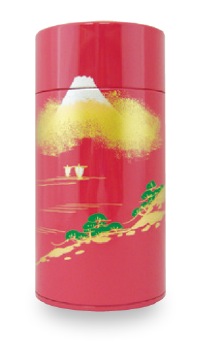
Fuji-to-Aomatsu (Mt. Fuji and Pine)
Mt. Fuji has long been revered as a sacred mountain, and continues to be the object of worship in Shintoism to this day.
Mt. Fuji, or Fuji-san, has been depicted in countless art pieces and is the quintessential symbol of Japan.
Having recently become a world heritage, the symmetry of Mt. Fuji continues to attract people worldwide today.

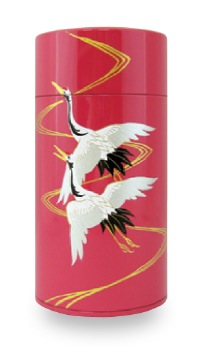
Niwa-Zuru (Cranes)
The crane is the national bird of Japan and has been an important part of Japanese culture and folklore for centuries. The crane symbolizes longevity and good fortune and is often woven into a wedding kimono as lucky symbol.
One famous folktale of the crane is called "The Grateful Crane," a story about a crane giving back to an old couple that saves it from a hunting trap. The crane transforms into a beautiful young lady to weave a cloth made from its own feathers.

Available Sizes
| Capacity: g | Capacity: oz | Size: (Ø) x (H) cm | Size: (Ø) x (H) inch | Comments |
|---|---|---|---|---|
| 100 g | 3.5 oz | 6.4 x 10.3 cm | 2.52 x 4.06 in. | with internal cap |
| 150 g | 5.3 oz | 7.3 x 11.4 cm | 2.87 x 4.49 in. | with internal cap |
| 200 g | 7.0 oz | 7.7 x 15.6 cm | 3.03 x 6.14 in. | with internal cap |

















